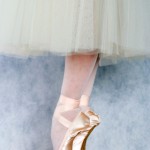Double pique turns are not hard. There’s a trick. The trick is to increase the speed of your turn.
A single pique and a double pique take the same amount of time. The difference between them is the speed.
You can try using more force to increase speed. But adding force to a turn will almost always throw it off.
The best way to increase speed is to decrease the diameter of your turn.
Imagine a necklace, a fine chain with a ballerina pendant on it. Unclasp the necklace and hold the two ends, one in each hand. Spin the necklace like a jump rope, so that the pendant is twirling around in nice big circles.
Now pull the two ends of the chain outward. What happens? The diameter of the spinning circle quickly gets smaller and the pendant spins around very much FASTER!
My husband is a rocket scientist. Rocket scientists know a lot about physics. I am always asking him questions because physics can really help with ballet.
So I asked him about speeding up turns by decreasing the diameter.
He said, “The polar moment of inertia equals mass times the radius squared.”
Now, don’t get glassy eyed and go away! There is a translation:
If you decrease the diameter of your turn by half, the speed of your turn will be almost FOUR TIMES FASTER!!!
Of course, other factors like friction and air resistance come into play. But the bottom line is that if you use the SAME amout of force and make your turn SMALLER, your turn will spin FASTER.
I explained that to a class I was teaching, and one of my students nodded her head emphatically and said, “Got it!” She then did a single pique followed by a quadruple!
I have never in my life seen anyone do a quadruple pique turn until this student did it! How did she do it?
You see ice skaters do it all the time. They are turning slowly with their arms out. Then they pull their arms in and their turns spin so fast, they are just a blur! They simply decreased the diameter of their turn. (or as my husband would say, “They decreased their polar moment of inertia.”)
I knew a dancer named Jimmy Capp. He could do a 12-revolution pirouette! We (the other dancers in the company) were always pestering him to show us his pirouettes over and over again. He would start with his arms almost in second, like the skaters we talked about. As he turned, he would gradually pull his arms in. His turns actually sped up, so he was going faster on the twelfth revolution than when he started!
Here are a few easy ways to speed up your turns and still keep good ballet form:
1) Tighten your stomach muscles:
a) If you’ve taken modern dance, you might be familiar with the “center”, your core abdominal muscles. Think of your core abdominal muscles in terms of cosmology – the stars, the solar system, etc.
b) You can expand your “center” like the sun, radiating your energy outward. Or you can compress it like a black hole. (“A black hole is a region in space in which the gravitational field is so powerful that nothing, including light, can escape its gravitational pull,” says my husband Ben)
c) When you do a single pique turn, hold your stomach muscles with a normal amount of tension.
d) When you start into multiple pique turns, compress your stomach like a black hole!
2) Pull your arms in a little:
a) This one is tricky, because you don’t want to lose form.
b) Do your single pique turn with nice big round arms in first position.
c) When you start into a multiple turn, bring your hands a little closer together and bend your elbows a little more, so that the circle you make with your arms is a little smaller, but still within correct form.
3) Take a smaller step:
a) This trick is pretty easy. This is the trick that my student used when she did her quadruple pique turn
b) Estimate the distance you step out for your single pique turn.
c) When you go into your multiple pique, take a shorter step. This works REALLY well for double pique turns on pointe because it actually brings you more on balance at the same time that it speeds up your turn.
4) Don’t forget to spot!
a) When you do a single turn you spot once. Your spot actually helps to bring you around on your turn.
b) When you do a double turn, you must spot twice. That means leaving your head, then spotting, leaving it AGAIN, then spotting again. In my mind, I always say, “LEAVE, TAKE, LEAVE, TAKE” whenever I do a double turn.
Good luck, and have fun with multiple pique turns! Let me know how you are doing. You can ask questions, too. Just click on “Leave a Comment” below.
 “How do I get over the fear of falling when I do a pirouette on pointe?” one of my students asked recently.
“How do I get over the fear of falling when I do a pirouette on pointe?” one of my students asked recently.